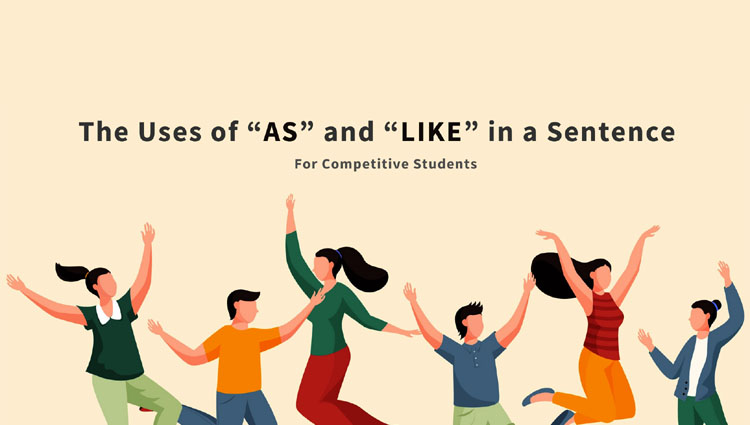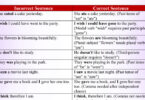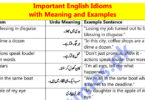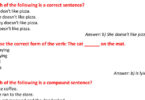Explaining the difference between “AS” and “LIKE”
Most of the non-native students, especially competitive students in Pakistan, don’t understand properly the difference between “Like” and “As”. In English, both words are usually interchangeable and used synonymously in sentences. But, these words are not similar in their meanings and usages.
Let’s look at the example to understand their difference:
- Like your mother, Sarah also wants you to qualify for the civil services examination, CSS.
- As your brother, Ali wants you to qualify for the civil services examination, CSS.
In the very first sentence, the word “Like” is used, which means that “Sarah” is not your real mother, but holds a similar position. She can be your elder sister, your ant, your cousin, or your well-wisher, who maintains the same feelings as your mother has for you. In the second sentence, the word “As” is used, which means “Ali” is your real father.
Understanding the difference between “As” and “Like” helps students write grammatically correct sentences. Since both words “As” and “Like” can be used for comparisons, the confusion among students is usually caused by a lack of understanding of the roles played by them within a sentence. The article is written by Sir Syed Kazim Ali, who is known as the best English language teacher in Pakistan, and it will explain the differences between both of the words through multiple examples.
The uses of “LIKE”: Explaining the difference
The word “LIKE” is a preposition, which is always used to connect a noun/pronoun to the other parts of the sentence (a verb or adjective in a sentence) and also tells where, when, or how the noun/pronoun is located within a sentence. Always remember, we use the word “Like” to compare two things (nouns/noun phrases) when we want to say that two things are similar. Moreover, “Like” is always followed by a Noun/Noun Phrase (Not – a clause) in a sentence.
Just look at the following examples: | Explaining the difference
1- Sarah, sometimes, acts like a child. (Not – as a child.)
In this example, the comparison is made between the two nouns (Sarah and Child). Thus, the word “LIKE” will be used (Not – “As”).
2- Mr. Akram is like a brother to me. (Not – As a brother to me.)
In this example, we are comparing two nouns (Mr. Armaghan and Brother)
3- Mr. Kamran, like his elder brother, has cracked the competitive exam. (Not – As his elder brother.)
In this sentence, the comparison is between two “nouns” (Mr. Kamran and His Elder Brother)
Check Also: Test Your Knowledge: English Grammar MCQs
4- Like the pandemic CoronaVirus, Pyelonephritis, a type of urinary tract infection, can also affect one or both kidneys. (Not – As the pandemic…)
In this example, we are comparing two things (nouns), (Corona Virus and Pyelonephritis)
5- Like the pandemic, Corona Virus, which is considered the deadliest in history, Pyelonephritis, which is a type of urinary tract infection, can affect one or both kidneys, and can also cause people to feel very sick if not treated properly. (Not – As the pandemic…)
6- Like embryonic germ cells, which develop early in the formation of the fetus and that later generate eggs or sperm, embryonic stem cells can develop into different kinds of body tissue. (Not – As embryonic germ cells…)
7- Like many other CSS aspirants, Kamran also remained unable to pass the precis and essay papers in the CSS exam just because of low-quality content and mentorship available in academies.
Other uses of “LIKE”: Explaining the difference
With the “Sense Verbs” (Look, Smell, Taste, Sound, Feel, Seem), we use “LIKE” (Not – As) while making a comparison.
1- It feels like a mushroom. (Not – As a mushroom.)
2- It smelt like medicine. (Not – As medicine.)
3- Nothing tastes like homemade biryani. (Not – As homemade biryani.)
4- Does it not sound like a cat? (Not – As a cat?)
5- Hajra looks like her elder sister. (Not – As her elder sister.)
Important Note: Explaining the difference
Sometimes we have to give examples within a sentence. Always remember, whenever you want to put examples inside a sentence, you can use “LIKE” or “Such As”.
1- To keep himself healthy, you must try a team sport like cricket, hockey, or football.
2- My dear you should take something soft, such as an exercise mat, to sit on.
3- Taking something soft, such as an exercise mat, to sit on will make you feel comfortable.
The Uses of “AS” | Explaining the difference
On the other hand, “AS” is used as a preposition and conjunction. Always remember, the word “As” as a conjunction is always used to connect clauses, phrases, and words.
The uses of “AS” as a Conjunction: Explaining the difference
1- There was no seat available to sit on, as we got into the classroom too late.
2- As the main door was locked, I had to jump the wall to get into my house.
3- As a clown showcases his talent through the theater, a writer can reach out to his readers through his write-ups.
Check Also: English Grammar MCQs
For other uses of “AS”, look at the following structures:
“As + Adjective + As” or “As Much As”. Both of the structures are often used when we want to say if something has, or doesn’t have, the same amount or quality that something else has, or does have.
- Nimra loves cats as much as her sister does.
- Ali likes spicy food as much as Amjad does.
- Mr. Sanwal travels as much as his father.
- That goat is as big as that child!
- She is not as expressive as I am.
- Mr. Mushtaq is not as tall as Mr. Yousaf is.
- My car is as expensive as your car is. (My car is as expensive as yours.)
While talking about someone’s JOB (position) or Functions of something, we use “AS” (Not – Like). In this case, the word “AS” must be followed by a noun (Not – a clause or phrase).
- Nowadays, she is working as a computer operator.
- Kamran has worked as an English teacher for five years in Pakistan.
- I can use my shawl as a blanket to keep myself warm.
We also use the word “AS” in place of the expression “The Same As”
- Texting is not the same as writing an official letter.
- Texting is not the same as speaking in person.
- Your laptop is the same as mine.
- Her car is the same as mine.
The word “As” has different meanings. It can be used in place of “While”, “During the time that” or “At the same time”
- I was called twice as I was taking a bath. (Miss. Hina called me twice while I was taking a bath.)
- As Amjad called me, I was leaving for office. (During the time that I was leaving, Amjad called me.)
- As we were walking down the road, we saw Sir. Armaghan and Sir. Shakeel. (At the same time we were walking down the road, we saw Sir. Armaghan and Sir. Shakeel.
The word “As” has different meanings. It can be used in place of the expression “In the way that”
- In the way that we know, the Howfiv website has started helping millions of students again. (As we know, the Howfiv website has started helping millions of students again.)
- In the way that I expected it, it started to rain. (As I expected it, it started to rain.)
- In the way that Sir Mushtaq said, I personally think the Howfiv website is a revolutionary step in the online education system of Pakistan. (As Sir Mushtaq said, I personally think the Howfiv website is a revolutionary step in the online education system of Pakistan.)
Takeaways
Always remember the following points about the words “As” and “Like”.
- Both like and as is used to present comparison but in different ways.
- “Like” must be followed by a noun/pronoun or noun phrase (Not – a clause or prepositional phrase) while presenting a comparison between two things. The word “Like” also has other uses.
- “As” must be followed by a clause or a prepositional phrase (Not – a noun, pronoun or noun phrase) while presenting comparisons. The word “As” also has other uses.
More Examples:
Let’s look at the following examples.
- Miss. Hina works as a teacher nowadays.
- She is very like her mother.
- She loves mangoes as much as her mother does.
- Mr. Kamran arrived as I was leaving for the office.
- He works in a software company, like his father.
- We used a tea towel as an oven glove and we burned it.
- Her perfume smells like flowers.
- As it was raining outside, I took an umbrella with me.
- Amreen is as intelligent as Armaghan is.
- She prepared for the CSS examination really hard like us.
- She looks like her sister.
- She often plays sports, like hockey, football, or cricket.
About the Author
The concept is explained by Sir Syed Kazim Ali on the request of CSSTimes, as we always provide quality to our users who are preparing for various examinations. Sir Syed Kazim Ali is the best English language teacher in Pakistan. He is one of the teachers who has recognized himself globally because of his adept command over the English language. The best part of him that has made Sir Syed Kazim Ali the best English language teacher in Pakistan is his art of teaching that helps students write their thoughts grammatically correct. He turns all of his students into the world’s best writers. The way he explains and simplifies the concepts no other English teacher across Pakistan can do. He has successfully taught hundreds of successful students preparing for entrance or competitive exams such as MDCAT, GAT, SAT, GMAT, GRE, CSS, FPSC, PMS, etc. Although he teaches advanced levels of English language to the students who want to pursue PhDs. in Europe or other developed countries, he teaches competitive students too. All of the characteristics he possesses make him the best English teacher in Pakistan.
CSSTimes really appreciates his contributions.








Very well explained..!
Finally found self explanatory post for such a confusing concept of Like and As , which I was looking for since so long. Thank-you CSS Times for bringing Sir Kazim’s superbly explained topic to all of us.. No doubt ,he’s the best teacher of Pakistan. Brilliant minded and exceptional teacher with magical pedagogical skills. This post has finally given us a sigh of relief with his phenomenal contribution.?
We request you to please request him for more of his detailed yet valuable explanations of this kind for us as CSS essay has been a nightmare. Now, I know why has Sir Syed Kazim Ali been all over the internet as best CSS English essay teacher in Pakistan.
Beautifully explained!
This post depicts an intellectual and brilliant mind , adept in the subject undoubtedly.
I request more explanations like these plz.
This article is very well explained and well-articulated. I was always confused between “As” and “Like”, but now this masterpiece written by Sir Syed Kazim Ali has made it clear. Undoubtedly, this article written by Sir Kazim Ali has clarified all of my ambiguities.
This article is very well explained and well-articulated. I was always confused between “As” and “Like”, but now this masterpiece written by Sir Syed Kazim Ali has made it clear. Undoubtedly, this article written by Sir Kazim Ali has clarified all of my ambiguities.